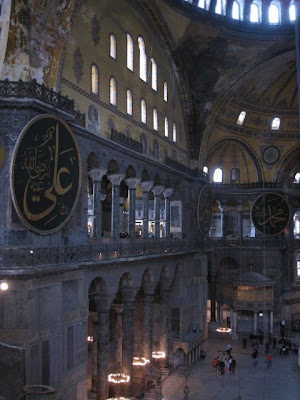Istanbul is a fascinating and beautiful city jam-packed with both sights and people (particularly with Australians making their annual ANZAC Day pilgrimage to Gallipoli). To call Istanbul exotic or mysterious sounds too cliched, but the city does have a unique essence that is impossible to ignore.
Bisected by the Bosphorus Sea, Istanbul sits with one half in Asia and one half in Europe. To a non-European, it has the feel of many large European cities: beautiful old palaces sit alongside swank new shops; narrow cobblestone streets veer off wide avenues lined with trees and cafes. And to someone from a (relatively) new country that proudly celebrates historic buildings only hundreds of years old, every street corner holds the promise of a glimpse of the distant past - an exquisitely tiled fountain or a crumbling fragment of ancient wall.
What makes Istanbul so alluring is the distinctive Eastern influence that permeates an otherwise "Western" city. The minarets and domes of countless mosques dominate the skyline, their competing calls to prayer echoing from all sides. Graceful Arabic calligraphy and intricately painted tiles in vibrant shades of blue and green decorate the walls of buildings. Instead of crepes and waffles, street vendors sell simit (a circular pretzel/bagel-type bread), roasted chestnuts and corn on the cob. And, of course, there's the ever-present turkish delight and baklava shops, interspersed with nargile (water pipe) cafes.

Istanbul is a city of minarets; here´s the view of the Blue Mosque from the top of the Ayasofya

The view crossing the Bosphorus from Asia to Europe. In the background is Sultanahmet, with the Ayasofya in front and the Blue Mosque behind.

The busy Eminonu ferry landing, near Sultanahmet

Fishermen line the upper deck of the Galata Bridge at dusk

The Beyoglu district of Istanbul
 A narrow street in Pamplona´s Old Town
A narrow street in Pamplona´s Old Town Pamplona´s Ayuntamiento, in the center of Old Town
Pamplona´s Ayuntamiento, in the center of Old Town Inside the Iglesia de San Saturnino, built in 1297
Inside the Iglesia de San Saturnino, built in 1297 Patrons enjoy wine and pintxos at a local bar. It´s customary to have a drink and one or two pintxos and then move along to another bar.
Patrons enjoy wine and pintxos at a local bar. It´s customary to have a drink and one or two pintxos and then move along to another bar. The Plaza del Castillo
The Plaza del Castillo The view from the Old City wall
The view from the Old City wall 
































 Istanbul is a city of minarets; here´s the view of the Blue Mosque from the top of the Ayasofya
Istanbul is a city of minarets; here´s the view of the Blue Mosque from the top of the Ayasofya 













